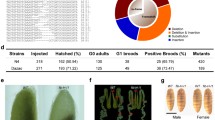Abstract
Large-scale production of recombinant spider silk proteins is a long-term goal for their industrial use. Therefore, we have recently developed a process for bacterial production. Due to a highly repetitive gene sequence of spider silks, the host strain E. coli BLR(DE3) was employed since it shows no homologue recombination. Although perfectly suited for production in full media, the BLR strain does not grow in cost-effective minimal media, indicating a previously not reported l-isoleucine auxotrophy. We provide evidence that mutated threonine deaminase is likely responsible for the detected auxotrophy of BLR.



Similar content being viewed by others
References
Daisuke K, Kensaku S, Saori S et al (2001) Shifted positioning of the anticodon nucleotide residues of amber suppressor tRNA species by Escherichia coli arginyl-tRNA synthetase. Eur J Biochem 268:6207–6213
Gallagher DT, Gilliland GL, Xiao G et al (1998) Structure and control of pyridoxal phosphate dependent allosteric threonine deaminase. Structure 6(4):465–475
Ham TS, Lee SK, Keasling JD et al (2006) A tightly regulated inducible expression system utilizing the fim inversion recombination switch. Biotechnol Bioeng 94(1):1–4
Huemmerich D, Helsen CW, Oschmann J et al (2004) Primary structure elements of dragline silks and their contribution to protein solubility and assembly. Biochemistry 43:13604–13612
Khushoo A, Pal Y, Mukherjee KJ (2005) Optimization of extracellular production of recombinant asparaginase in Escherichia coli in shake-flask and bioreactor. Appl Microbiol Biotechnol 68(2):189–197
Korz DJ, Rinas U, Hellmuth K et al (1995) Simple fed-batch technique for high cell density cultivation of Escherichia coli. J Biotechnol. 39(1):59–65
Paliy O, Gunasekera TS (2007) Growth of E. coli BL21 in minimal media with different gluconeogenic carbon sources and salt contents. Appl Microbiol Biotechnol 73(5):1169–1172
Riesenberg D (1991) High-cell-density cultivation of Escherichia coli. Curr Opin Biotechnol 2:380–384
Scheibel T (2004) Spider silks: recombinant synthesis, assembly, spinning and engineering of synthetic proteins. Microb Cell Fact 3:14–24
Vendrely C, Scheibel T (2007) Biotechnological production of spider silk proteins enables new applications. Macromol Biosci 7:401–409
Acknowledgements
We thank Christian Ackerschott and Christian Patzig for experimental support. This work is supported by the DFG (SCHE 603/4-2).
Author information
Authors and Affiliations
Corresponding author
Additional information
M. Schmidt and L. Römer contributed equally to this work.
Rights and permissions
About this article
Cite this article
Schmidt, M., Römer, L., Strehle, M. et al. Conquering isoleucine auxotrophy of Escherichia coli BLR(DE3) to recombinantly produce spider silk proteins in minimal media. Biotechnol Lett 29, 1741–1744 (2007). https://doi.org/10.1007/s10529-007-9461-z
Received:
Revised:
Accepted:
Published:
Issue Date:
DOI: https://doi.org/10.1007/s10529-007-9461-z




